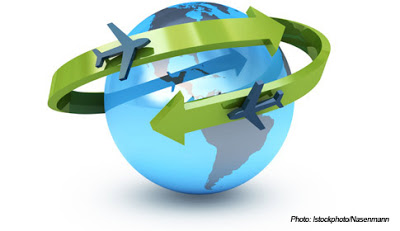There is always something to learn in this miles and points game! Always. Recently I discovered something when booking an award ticket that you may already know. But if you don’t, maybe you’ll learn something new from my sharing what I discovered.
I was booking a trip to Asia but only had enough miles to book an award for either the outbound or the inbound. In deciding which direction to use miles and which direction to pay cash, I started looking at cash prices. I looked at Japan Airlines website for their prices. I searched starting from the states and saw the oneway ticket priced around $650 for an economy seat. I assumed that this was half of the roundtrip cost. This led me to assume the fare from Japan to the States, should I opt to use the inbound as my cash outlay, would be the same $650. Wow, was I wrong!

Image source: https://lccaroundtheworld.blogspot.com/2008/11/how-to-fly-around-world-for-1-200-euros.html
When I checked the one way price from Japan to the states it was $4,000. I did a double and triple take. In my naturally enthusiastic way I thought, “Maybe they added one too many zeros and the fare back to the States was even lower than to Japan.” Silly thought, right?
Out of curiosity I checked to see how many miles the one way $4,000 flight would cost. It was 35,000 miles. This gave me a good laugh because those 35,000 miles now buys a $4,000 seat! That’s an amazing value but we don’t have to tell anyone it was an economy seat. That can be our secret!
Obviously I’d go with the outbound fare of $650, but here’s the key takeaway. I asked my award booking team about this because they look at fares all day long. I wondered what I was missing in how fares are priced. Here’s what they told me:
The one way ticket being 1/2 the cost of a roundtrip is a USA thing. Basically, we’ve gotten to the point where things are priced as one ways in the US. However, international fares are almost never priced that way with one-ways being half the cost of a round trip. Also, they usually have requirements such as a Saturday night stay or minimum stay requirements. I don’t know why JAL does it only in one direction, but you’ll see this a lot on fares to Europe where a one-way costs more than the roundtrip.
I filed this away as something to remember. It’s not that I pay cash for long haul flights very often, but this reminded me not to assume anything about airfares and to not be so shocked next time I see a high gap like this in cost.
Is this something you already knew? What other tips have you learned when pricing out long-haul tickets? Share them in the comments below!


Fun one I’ve run into.
Prefer JAL since they have a Tokyo-Boston direct, but due to the pricing differences, booking gets interesting…
Once looked up a Boston – Los Angeles – Hawaii – Tokyo – Boston itinerary… flying in that order on Jetblue/Hawaiian on the outbound and JAL on the inbound cost around $6000 due to combining 4 one way legs.
Looking up two separate roundtrips with JAL Boston – Tokyo and Tokyo – Hawaii, it came out to about $3000
You have a funny sense of humor, JK :) It will be more fun the next time this happens than the shocker I got. Great itinerary you were looking at! Thanks for reading.
Nested round trips can still offer good value on international flights. It’s a trick I learned back in the bad old days of domestic flights when Saturday stays were a thing. I often flew LAX/SNA/LGB-DTW for work and the typical price for a midweek RT in coach was about $1400. Add a Saturday night stay over and the RT dropped to $250-$400. I regularly booked a RT from Southern California to Detroit and then another RT from Detroit. I’d push the returns out to the max, then reschedule/rebook when I needed to fly again. Thanks to the corporate travel department in reality, a dedicated Amex agent), there were rarely any change fees. I threw away more than a handful of return legs entirely and still saved the company significantly.
Great addition to the conversation, Mallthus. Thanks! That’s a huge savings. In the future I’ll be on the look-out for this possibility on international flights.
It is much less about not being half a r/t and much more about international fares rarely being symmetrical. Even if they were r/t fares the likelihood of A->B matching B->A is relatively low.
Thank you for pointing this out. Good way to say it, W.A. That’s exactly what I learned that I never realized before.